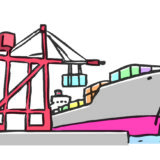輸入代替工業化
輸入している工業製品を国内にて製造することで近代的工業化を図ること。そのようにして経済を成長させようという政策。1950~60年代にラテンアメリカ諸国やアジアの国々で実施された。モノカルチャー経済からの脱出を図る方策の一つであり、関税や輸入数量割当などの保護措置が取られた。それによって海外市場から隔離されて国内市場が発展することとなった。しかしこうした保護貿易の政策は国内市場で効率的な配分を損なったり、財政負担も大きくなったりするため、輸出指向工業化へ政策の転換が必要とされていく。
Import substitution industrialization
Import substitution industrialization is a policy that promotes modern industrialization by replacing foreign imports with domestic production and aims at economic growth. The policy was implemented in countries in Latin America and Asia in the 1950s and the 1960s. It was one of the means to break away from monoculture economy. Under the policy, protective measures are taken such as imposing tariffs and introducing import quota. Those measures separated the domestic market from overseas influences and helped it develop. However, the protective policies undermine efficiency of distribution in the domestic market and place a financial burden on the government. Thus, the government needs to switched to export-oriented industrialization in due course.
保護貿易主義
国家が貿易に一定の干渉を加えて自国産業、国内市場の育成・防衛を図る考え方や政策のこと。輸出入の統制・奨励と、関税政策がそれにあたる。重商主義がすすめられていた17世紀でのイギリスでは、高率関税、輸出奨励金などの保護が行われていた。またドイツでは工業化が立ち遅れたため、ドイツ関税同盟で域内の関税を廃止した。フリードリヒ・リストが保護貿易主義による工業化はやむを得ないとし、アメリカもこれを参考に保護関税政策を主張した。
Protectionism
Protectionism is a policy in which the government interferes with international trade to develop and protect the domestic industries and market. Protectionist measures include tariff policies and control and promotion of trade. In the 17th century in England, where mercantilism was promoted, protective measures were taken such as high tariffs and export subsidies. In Germany, where industrialization was slow, the government abolished customs within the territories of German Customs Union. Friedrich List argued that the national economy required protectionist measures to achieve industrialization, and based on the idea, the United Stated made a case for its protective tariff policy.
輸出志向工業化
発展途上国が自国へ外資系企業の誘致を促すなどして、工業製品の生産や輸出を拡大していく政策。工業化、経済成長を実現しようとする政策。関税の引下げ、輸出加工区の設置、関連インフラの整備、技術導入・研究開発への支援、そういった施策が具体的に実施されたりする。輸入代替工業化を政策に採用した国家は、やがて輸出志向工業化へ政策の転換をする必要があると言われている。NIESや ASEAN諸国は、その転換が成功した例として挙げることができる。
Export-oriented industrialization
Export-oriented industrialization is a policy that aims at industrialization, economic growth, and production and export expansion in developing countries by attracting foreign companies. Measures taken in the process include tariff reductions, introduction of export processing zones, related infrastructure development, support for technical implementation, and investment in research and development. It is said that nations that have adopted import substitution industrialization will have to make a shift to export-oriented industrialization. NIES and ASEAN nations are known as examples of countries that have succeeded in the shift.
キーワードの解説
海外に自動車を輸出する日本。日本の自動車は海外市場に進出し世界的にも有名ですね。もちろん日本国内でも日本車は流通しています。いま日本車は国内市場でも流通していますね。しかし自動車を製造する国が全て日本のような国でしょうか。国内市場で自国車の流通があっても輸出をしているとは限りません。海外市場に進出し世界的に有名になるには国際競争力が必要です。ここで国際競争力とは質。自動車であれば性能や燃費などでしょう。それを満足のいく価格で提供できれば、たくさんの国ぐにの自動車会社に先を争って、たくさんの国ぐにの消費者を惹きつけて有名になれるのではないでしょうか。
その一方で、国によっては、そのような国際競争力をもたない自国車、しかし自国では通用して流通している自動車を、製造していることもあります。そのうえで、その国が自由貿易を採用すれば、その国からみた外国車(ここには日本車も含まれるかもしれませんね)に国内の消費者までもが奪われてしまうかもしれません。そこまで考えたうえで保護貿易という政策を採用する場合があるのです。具体的には外国車に関税をかけて「外国車は質が高いかもしれませんが値段が高いですよ」、そのようにして対抗してみせるのですね。
※国際関係!徹底マスター用語解説で、用語は、国際関係のファカルティの編入学試験で出題された過去問題から選んでいます。



